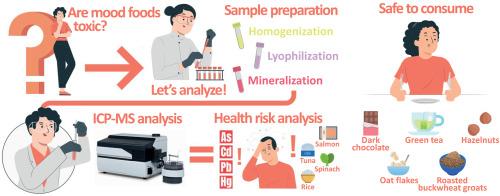Heavy metals and metalloids in selected Mood Foods in Poland: Development of sample preparation and analysis methods and assessment of the health risks of consumption
IF 3.5
3区 医学
Q2 FOOD SCIENCE & TECHNOLOGY
引用次数: 0
Abstract
The subject of the study are Mood Foods, food products that improve well-being and are widely recognized as healthy, but just like other food products, they could be sources of heavy metals in human diet. Elements, such as mercury, lead, cadmium and arsenic, which have neurotoxic effects, can be found in food as a result of air, soil, and underground and groundwater pollution. Therefore, the study aimed to (1) develop and optimize universal sample preparation and ICP-MS analysis methods with high repeatability and recovery, (2) qualitatively and quantitatively analyze arsenic, cadmium, mercury and lead contents in various mood food products – hazelnuts, instant oat flakes, roasted buckwheat groats, salmon, tuna, spinach, dark chocolate, rice and green tea, and (3) describe the obtained results and assess the health risk – by calculating Estimated Daily Intake, percentage of Provisional Tolerable Weekly Intake, Target Hazard Quotient, Hazard Index, and Carcinogenic Risk – due to consumption of foods containing elements at determined content levels: As: 3.429–4745.289 μg kg−1, Cd: 3.583–721.572 μg kg−1, Hg: 0.355–3044.705 μg kg−1, and Pb: 12.614–1246.174 μg kg−1. It has been shown that regular consumption of certain mood food products could pose non-carcinogenic and carcinogenic health risk to consumers.

波兰选定Mood食品中的重金属和类金属:制定样品制备和分析方法,并评估消费的健康风险
这项研究的主题是心情食品,这种食品可以改善幸福感,被广泛认为是健康的,但就像其他食品一样,它们可能是人类饮食中重金属的来源。汞、铅、镉和砷等具有神经毒性作用的元素,由于空气、土壤、地下和地下水污染,可以在食物中发现。因此,本研究旨在(1)开发和优化具有高重复性和高回收率的通用样品制备和ICP-MS分析方法;(2)定性和定量分析各种情绪食品(榛子、即食燕麦片、烤荞麦、鲑鱼、金枪鱼、菠菜、黑巧克力、大米和绿茶)中砷、镉、汞和铅的含量;(3)描述所得结果并评估健康风险-通过计算估算每日摄入量。暂定每周可耐受摄入量百分比、目标危害商、危害指数和致癌风险——由于食用含有以下确定含量水平的元素:砷:3.429 - 474.5.289 μg kg - 1,镉:3.583-721.572 μg kg - 1,汞:0.355-3044.705 μg kg - 1,铅:12.614-1246.174 μg kg - 1。研究表明,经常食用某些情绪食品可能对消费者造成非致癌性和致癌性健康风险。
本文章由计算机程序翻译,如有差异,请以英文原文为准。
求助全文
约1分钟内获得全文
求助全文
来源期刊

Food and Chemical Toxicology
工程技术-毒理学
CiteScore
10.90
自引率
4.70%
发文量
651
审稿时长
31 days
期刊介绍:
Food and Chemical Toxicology (FCT), an internationally renowned journal, that publishes original research articles and reviews on toxic effects, in animals and humans, of natural or synthetic chemicals occurring in the human environment with particular emphasis on food, drugs, and chemicals, including agricultural and industrial safety, and consumer product safety. Areas such as safety evaluation of novel foods and ingredients, biotechnologically-derived products, and nanomaterials are included in the scope of the journal. FCT also encourages submission of papers on inter-relationships between nutrition and toxicology and on in vitro techniques, particularly those fostering the 3 Rs.
The principal aim of the journal is to publish high impact, scholarly work and to serve as a multidisciplinary forum for research in toxicology. Papers submitted will be judged on the basis of scientific originality and contribution to the field, quality and subject matter. Studies should address at least one of the following:
-Adverse physiological/biochemical, or pathological changes induced by specific defined substances
-New techniques for assessing potential toxicity, including molecular biology
-Mechanisms underlying toxic phenomena
-Toxicological examinations of specific chemicals or consumer products, both those showing adverse effects and those demonstrating safety, that meet current standards of scientific acceptability.
Authors must clearly and briefly identify what novel toxic effect (s) or toxic mechanism (s) of the chemical are being reported and what their significance is in the abstract. Furthermore, sufficient doses should be included in order to provide information on NOAEL/LOAEL values.
 求助内容:
求助内容: 应助结果提醒方式:
应助结果提醒方式:


